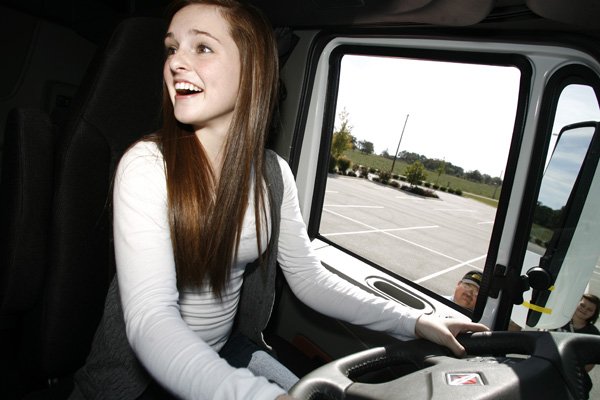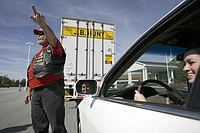ROGERS — Gunner Reynolds wants to be certain he’s 100 percent ready to drive before he takes the wheel of a vehicle.
The Springdale High School student turned 16 in July, and he’s not certain he’ll be fully prepared to take the driver’s license exam by thetime he turns 17 next summer.
He’s in no hurry.
“I don’t want to get one until I can trust myself,” said Reynolds, who’s taking a Driving Academy of Northwest Arkansas course to prepare himself for the road. “I’m afraid I’ll get in a wreck.
“If (my friends) want todrive, that’s up to them, but this is me.”
Statistics kept by the Arkansas Department of Finance and Administration’s Office of Driver Services show a decreasing number of 16- and 17-year-olds in the state are licensed drivers.
The 16-year-old drivers decreased from 18,709 in 2000 to 16,062 last year.The 17-year-olds followed a similar pattern, sliding from 25,060 to 22,710 in the same nine-year span.
“Parents are all confused, and they don’t get it,” said Kimma Harper, the driving academy’s president and one of its instructors. “Their kid doesn’t want to drive. It does seem to be a trend.”
Or maybe driver-to-be Gunner Reynolds is no different than a good portion of people who aren’t eager to drive after reaching age 16, said Rob Foss, a research scientist and director of the Center for the Study of Young Drivers at the University of North Carolina. The Arkansas decrease in 16-and 17-year-old drivers over the past decade is small enough that it could be “drift” rather than evidence of a trend, he said.
“This notion of teenagers not wanting to drive is starting to become something like an urban legend,” Foss said. “We have looked over time in North Carolina, and it’s down 2 [percent] or 3 percent over 20 years. It’s nothing to write home about. I don’t know that a 3 percent change over 20 years can be found to have a cause. It’s just not that much.”
FOND MEMORIES
Jeannie Dunaway, Reynolds’ grandmother, remembers being a young person in the 1960s who couldn’t wait to become a licensed driver. By the time she was 14, she was driving 2 1/2 miles to the place where she met the Springdale School District bus. It was way too far to walk.
“When I was 9 years old, I was in a field with a stick shift learning by myself,” Dunaway said. “Gunner doesn’t seem to be that way.”
Lots of adults have similar memories of everyone wanting to drive back when they were teenagers, Foss said.
“They are comparing evidence now with their idiosyncratic memories of the past,” Foss said. “Recollections of the past on this issue are mostly wrong. What we remember is fogged by years of memory.What we saw was a very narrow world around us.”
Supporting Foss’s view that teenagers are just as interested in driving today as they’ve always been is Howard Leatherwood, a coach who teaches four driver education courses at Lake Hamilton Junior High School in the Garland County town of Pearcy.
Leatherwood’s courses are packed with ninth-graders who are mostly age 14.
There’sa waiting list to get into the classes.
“My kids are enthused,” Leatherwood said. “It’s part of their growing up. When a kid gets to drive, it gives him more freedom.”
Gerald Cooper, the Melbourne School District superintendent, said he’s been around teenagers long enough to know they are just as interested in driving as they’ve always been.
The district had 52 ninthand 10th-graders take a driver’s education course last year, according to statistics kept by the Arkansas Department of Education. Auto insurance companies give discounts to students who take driver education courses.
“A lot of our kids work after school and they depend on a car to get to work,” Cooper said. “If they don’t drive to work, they have no way to work.”
Fewer Arkansas junior high and high schools are offering driver’s education as an accredited course, down from 125 during the 2007-08 academic year to 117 last year, Education Department records show.
Arkansas students taking driver’s education courses for credit has decreased, too, to 5,231 last year. That’s down 700from two years earlier.
At A-1 Thompson Driving School in Little Rock, Bennett Thompson said he’s noted more students who are 18, 19 and 20 years old who are taking a driving course.
“We can’t figure out why,” said Thompson, the school’s office manager. “It might not be that they don’t want to drive. It might be that economy question.”
ECONOMY FACTOR
Foss said the difficult economy may explain why fewer 16 and 17 year olds in Arkansas are licensed than three years ago. There were 43,447 drivers of that age in 2006 and 38,772 last year, state statistics show.
The numbers don’t support evidence of a long-term downward trend of teenagers being disinterested in driving, Foss said.
Newspaper and television reports are flawed that describe how teenagers would rather talk on cell phones and send text messages or that they don’t need to visit friends because they stay in touch using social networks such as Facebook, Foss said.
“They do that, but to say that’s why they don’t drive, it’s a little bit judgmental of teens,” Foss said. “Nothing we’ve seen in 17 years of talking with teenagers suggests teens are nearly as casual or irresponsible or lazy as the public perception of them. What we do see is responsible, level-headed stuff. They aren’t adults, but the notion of them as uncaring about driving is just a gross overstatement.”
Several students in Harper’s course are eager to drive, including Rogers High School student Shayla Ledbetter and Springdale Har-Ber High School student Cullen Miller.
“I’m tired of my mom driving me everywhere,” said Miller, who turns 16 in March.
Bentonville High School student Dylan Villarreal said the toy school bus he’s kept in his pants pocket for years is proof that he loves the prospect of driving someday.
“I’ve wanted to learn to drive since I was 5,” Villarreal said.
There are a group of students in Harper’s course, however, who’ve waited at least a little while longer to get behind the wheel - for all sorts of reasons.
Haley Huckaby, who turned 16 in August and expects to take the driver’s license exam around Thanksgiving, said her mom was kind after she drove thefamily’s car into a curb. The tire went flat the following day, Huckaby said.
“Driving makes me really nervous,” said Huckaby, who attends Bentonville High School.
Sharon Huckaby, who was 17 when she got her driver’s license, said she’s noticed her daughter’s delayed interest. They’ve talked about it.
“She’s just not anxious at all,” Sharon Huckaby said.
Northwest Arkansas, Pages 17 on 10/24/2010



